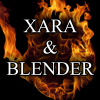Sometimes, you want a texture mapped to an object, but not the whole texture. For example decals applied, or perhaps just a proportion of the object has this secondary texture, etc.
If you want to do it on border lines that MATCH the geometry of the object, ie. a group of faces that will have this other texture, then it is easily done by just using the Assign command on those faces.
For those cases where you don't want it to make the change on face borders, what to do?
Empty-controlled mapping to the rescue.
With this technique, the original set-up of faces makes no difference. The empty will control how the texture is "available" for the object.
To show what I mean... look at the following simple (and rough)anim to show what I mean. There is NO changing of the object itself or its assigned faces. The only "movement" in the anim is the repositioning of the empty.
All you need is an Empty which will control where the image is mapped. Remember that the mapped image will always show (unless you change the relevant axes) in the POSITIVE X and Y of the empty. The Z axis will control how deep the texture is allowed to affect the object.
For this, you must set the Coordinates in the image mapping to Object, and then choose the Empty. Additionally, set "Clip Cube" rather than Repeated so that the texture stops at the boundaries of the Empty.
There are MANY applications for this, even though the example is quite simple and might seem not so useful.
As an example, if you had a plastic goblet and you wanted it to slowly (ie. smoothly) turn from plastic to gold, then this would be the way to do that. The movement of the Empty would make it all happen smoothly.
Another (non-animated) example... say you have made a glass and later you decide that you want to make a metallic, gold rim at the top of the glass. It does not matter the geometry of the object (ie. where the edges of the faces are), the empty can control as much or as little as you want without having to have any concern with the underlying geometry. Cool!
Peace
James





 Reply With Quote
Reply With Quote








Bookmarks